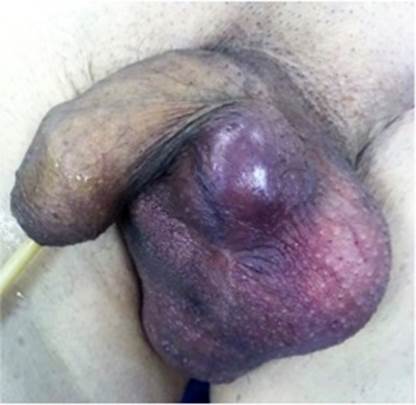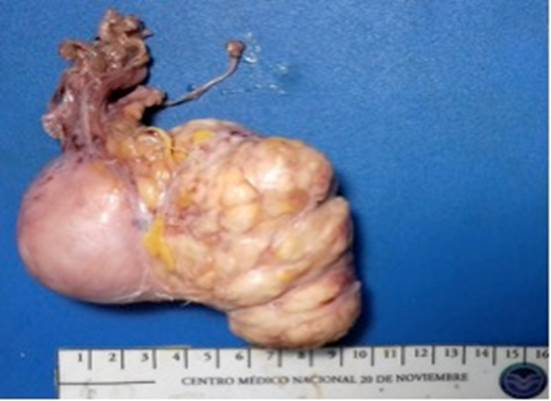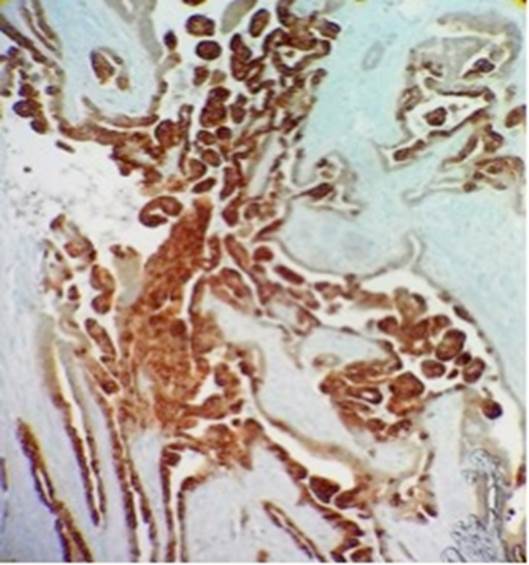Casos clínicos
Adenocarcinoma of the rete testis associated with castration-resistant prostate cancer
Adenocarcinoma de la red testicular asociado con cáncer de próstata resistente a la castración
Roberto Cortez-Betancourt1
Emilio Ramírez-Garduño1
Alejandro Alías-Melgar1
Fernando Carreño-de la Rosa1
Pedro Jair Botello-Gómez1
Eric Iván Trujillo-Vázquez1
Adolfo González-Serrano1
1Department of Urology, Centro Médico Nacional 20 de Noviembre, Mexico City, Mexico.
Abstract
BACKGROUND:
Adenocarcinoma of the rete testis is a very rare diagnosis with only about 60 reported cases. To the best of our knowledge, the present report is the first on that tumor associated with prostate cancer.
CLINICAL CASE:
An 84-year-old man with a history of castration-resistant prostate cancer presented with a non-tender, solid, right testicular mass. Tumor markers were within normal limits. The patient underwent radical inguinal orchiectomy and the pathology study reported adenocarcinoma of the rete testis. Diagnosis was confirmed through immunohistochemistry and staining was positive for high molecular weight cytokeratin (CK HMW) and cytokeratin 5/6, and negative for PSA.
CONCLUSION:
Adenocarcinoma of the rete testis is a very rare condition. Clinical presentation of those tumors is nonspecific, and the diagnostic immunohistochemistry profile has not been well defined. Prognosis is poor, with a short overall survival rate.
Keywords: Adenocarcinoma; Immunohistochemistry; Orchiectomy; Rete testis; Testicular neoplasms
Resumen
ANTECEDENTES:
El adenocarcinoma de la red testicular representa una enfermedad rara, con solo 60 casos reportados en la bibliografía. En nuestro conocimiento, este es el primer caso reportado de una neoplasia similar asociada con cáncer de próstata.
CASO CLÍNICO:
Paciente masculino de 84 años de edad, con antecedente de cáncer de próstata resistente a la castración, manifestado como una masa testicular derecha, sólida, no dolorosa. La determinación de marcadores resultó dentro de los límites de referencia. Se realizó orquiectomía radical derecha y mediante el estudio histopatológico se estableció el diagnóstico de adenocarcinoma de la red testicular. Las tinciones para citoqueratina de alto peso molecular y citoqueratinas 5 y 6 resultaron positivas; el antígeno prostático resultó negativo.
CONCLUSIÓN:
El adenocarcinoma de la red testicular es una neoplasia poco común, su manifestación es inespecífica y el diagnóstico por inmunohistoquímica sigue discutiéndose. El pronóstico es malo, con supervivencia global corta.
Palabras clave: Adenocarcinoma; immunohistoquímica; orquiectomía; red testicular; rete testis; tumor testicular
INTRODUCTION
Primary adenocarcinoma of the rete testis was first reported by Feek and Hunter in 1945.1
It is a very rare diagnosis, with only about 60 reported cases. It tends to be found in the elderly, with its peak incidence in patients 70 years of age.2
To the best of our knowledge, the present report is the first on adenocarcinoma of the rete testis associated with prostate cancer.
CLINCIAL CASE
An 84-year-old man presented with a history of castration-resistant prostate cancer treated with abiraterone acetate and prednisone and a history of urinary retention, with an indwelling catheter.
Physical examination revealed a non-tender, solid, poorly-defined right testicular mass. Neither the testis nor the epididymis could be identified at palpation. Tumor markers were within normal limits (Figure 1). The patient underwent radical orchiectomy and pathologic evaluation was carried out.
Macroscopic examination of the surgical specimen showed a 9 x 7 x 6-cm whitish, rough, renitent, heterogeneous mass (Figure 2).
Histologically, the tumor was a well-defined adenocarcinoma of the rete testis with a biphasic pattern, infiltration of the tunica vaginalis and epididymis, and lymphovascular invasion. Immunohistochemistry staining was positive for high molecular weight cytokeratin (CK HMW) and cytokeratin 5/6, and negative for PSA (Figure 3). After those findings, chemotherapy was offered but it was refused.
DISCUSSION
Adenocarcinoma of the rete testis is a very rare entity. Upon initial evaluation, patients tend to have sought medical attention for a non-painful testicular mass, and tumor markers are usually negative.3
In some cases, physical examination can evidence an associated inguinal hernia, hydrocele, undescended testis, epididymitis, or hematocele.4
Our patient presented with none of those conditions. On the other hand, he had a history of castration-resistant prostate cancer, and to the best of our knowledge, the present report is the first on adenocarcinoma of the rete testis associated with prostate cancer.
Diagnosis is made according to pathologic findings. A few cases have been evaluated using immunohistochemistry and were positive for cytokeratin, epithelial membrane antigen, and carcinoembryonic antigen. However, the immunohistochemistry profile has not been well defined.5-7
All the criteria for diagnosing primary carcinoma of the rete testis, which have been reported and revised by Nochomovitz and Orenstein, were fulfilled in the current case: absence of histologically similar extra-scrotal tumor that plausibly could be the primary site, tumor centered on the hilum, morphology incompatible with any other type of testicular or paratesticular tumor, and immunohistochemical exclusion of other possibilities.8
In our case, metastatic extension from the prostate was excluded due to negative staining for PSA.
Because adenocarcinoma of the rete testis is extremely rare, there is a lack of consensus regarding treatment and follow-up strategies. Consequently, prognosis of those neoplasms is poor, with a 5-year survival rate of 13%.9
Different adjuvant therapies have been described: retroperitoneal lymph node dissection, radiotherapy, and chemotherapy; all of them inducing only poor response.10
Data are scarce regarding treatment and follow-up strategies due to the rarity of the tumor.
Immunohistochemistry could be useful for achieving an accurate diagnosis in such cases.
REFERENCES
1 Gruber H, Ratschek M, Pummer K, et al. Adenocarcinoma of the rete testis: report of a case with surgical history of adenomatous hyperplasia of the rete testis. J Urol. 1997; 158(4):1525-6.
[ Links ]
2 Che-An W, Yung-Hsiang C, Kee-Ming M, et al. Papillary Adenocarcinoma of Rete Testis Mimics Inflammatory Lump: A Case Report. Case Reports in Urology, vol. 2011, Article ID 857812, 3 pages, 2011. doi:10.1155/2011/857812. Accessed 04. 01. 17.
[ Links ]
3 Spataro V, Caldiera S, Rusca T, et al. Adenocarcinoma of the rete testis. J Urol. 2000; 164(4): 1307-8.
[ Links ]
4 Mehra BR, Thawait AP, Narang RR, et al. Adenocarcinoma of the rete testis with uncommon presentation as haematocele. Singapore Med J. 2007; 48(12): e311-13.
[ Links ]
5 Nakagawa T, Hiraoka N, Ihara F, et al. Primary adenocarcinoma of the rete testis with preceding diagnosis of pulmonary metastases. Int J Urol. 2006; 13(12):1532-5.
[ Links ]
6 Pei-Wen H, Kuo-Ming C. Adenocarcinoma of the rete testis with prominent papillary structure and clear neoplastic cells: Morphologic and immunohistochemical findings and differential diagnosis. Indian J Pathol Microbiol. 2015 Apr-Jun; 58(2):232-4. doi: 10.4103/0377-4929.155328. Accessed 04.01.17.
[ Links ]
7 Prithwijit G, Kaushik S. Primary adenocarcinoma of rete testis with distinct biphasic pattern: An extremely rare entity and diagnostic challenge. J Nat Sci Biol Med. 2015; 6(1):211-3.
[ Links ]
8 Nochomovitz LE, Orenstein JM. Adenocarcinoma of the rete testis. Consolidation and analysis of 31 reported cases with a review of miscellaneous entities. J Urol Pathol 1994; 2:1-37.
[ Links ]
9 Perry BB, Outman JE, Olsen LT, et al. Adenocarcinoma of the rete testis presenting in an undescended testicle. J Urol. 2003; 170(4 Pt 1):1304.
[ Links ]
10 Chovanec M, Mego M, Sycova-Mila Z, et al. Adenocarcinoma of the Rete Testis -a Rare Case of Testicular Malignancy. Klin Onkol 2014; 27(2): 136-137.
[ Links ]











 nueva página del texto (beta)
nueva página del texto (beta)





